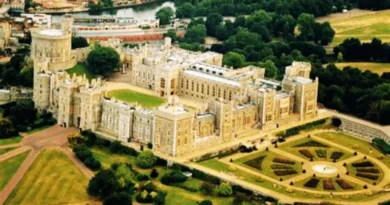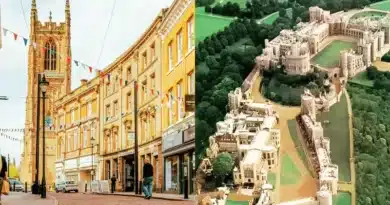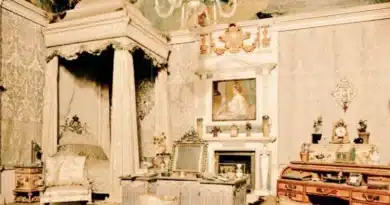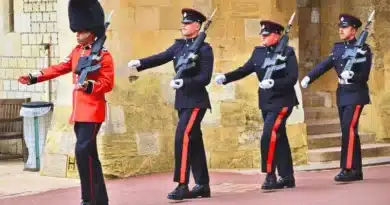Devastating Timeline of the Windsor Castle Fire 1992
Here is a concise table based on the timeline of the Windsor Castle Fire in 1992:
| Time | Event Description |
|---|---|
| 11:15 a.m. | Fire starts in Queen’s Private Chapel due to a spotlight placed too close to a curtain. |
| 11:32 a.m. | Chapel evacuated due to intense heat and falling embers. |
| 11:36 a.m. | Fire alarm raised; Royal Berkshire Fire and Rescue Service called. |
| 11:41 a.m. | Castle’s fire brigade arrives. |
| 11:44 a.m. | First fire and rescue vehicles reach the site. |
| 11:56 a.m. | 17 pumping appliances requested; efforts to save furniture and artwork begin. |
| 12:12 p.m. | 20 fire engines on scene. |
| 12:20 p.m. | Fire reaches St George’s Hall; 35 fire engines and 225 firefighters present. |
| 1:30 p.m. | Firebreaks set up in the Green Drawing Room; roof of State Apartments starts to collapse. |
| 3:30 p.m. | Brunswick Tower floors collapse; firefighters temporarily pull back. |
| 4:15 p.m. | Fire flares up again in Brunswick Tower. |
| 6:30 p.m. | Flames reach 50 feet high in Brunswick Tower. |
| 7:00 p.m. | Roof of St George’s Hall collapses |
| 8:00 p.m. | Fire under control after 9 hours. |
| 11:00 p.m. | Main fire extinguished. |
| 2:30 a.m. (Next day) | Last secondary fires put out; fire completely extinguished after 15 hours. |
Let’s discuss in detail:
On November 20, 1992, a devastating fire broke out at Windsor Castle, the world’s oldest and largest inhabited castle. The fire started in the Queen’s Private Chapel and quickly spread to the St. George’s Hall.
Firefighters arrived on the scene within minutes, but the fire was already raging out of control.
The fire spread to several key areas, including St. George’s Hall and other castle parts. While some valuable items were destroyed, and many valuable artworks were saved.
Timeline of the Windsor Castle Fire 1992

11:15 a.m. to 12:00 p.m.
The fire started in the Queen’s Private Chapel at 11:15 am when a curtain caught fire after a spotlight was placed too close. At the time, some members of the Royal Household were checking on art pieces in the chapel. A fire alarm sounded in the castle’s fire brigade room, where Chief Fire Officer Marshall Smith was on duty.
A light on a map showed the fire’s location, initially indicating the Brunswick Tower. However, more lights soon flashed, showing the fire spreading to nearby rooms.
A large part of the State Apartments quickly became engulfed in flames. Some building workers nearby tried to put out the fire using extinguishers. The 30-foot-long curtains eventually fell to the ground and continued to burn. People in the chapel hurriedly started removing paintings, but the growing heat and falling embers forced them to leave by 11:32 am.
At 11:36 am, Smith alerted the control room at Reading fire station. He then set off the castle’s public fire alarm and called the Royal Berkshire Fire and Rescue Service, saying, “Windsor Castle here; we have a fire in the Private Chapel. Come to the Quadrangle as arranged.” The castle had a fire brigade of 20 people, six working full-time. They were based in stables two miles away and arrived at the castle by 11:41 am.
Fire and Rescue Service vehicles reached the site by 11:44 am. By 11:56 am, 17 pumping appliances had been requested. Efforts to save furniture and artworks began, involving castle staff, construction workers, and Prince Andrew, one of the Queen’s sons.
12:00 p.m. to 03:00 p.m.
By 12:12 pm, there were already 20 fire engines on the scene; by 12:20 pm, this number had increased to 35. Over 200 firefighters from London, Buckinghamshire, Surrey, and Oxfordshire had been brought in, in addition to the local Berkshire team. The fire was being managed by David Harper, the Deputy Chief Fire and Rescue Officer, as the Chief Officer, Garth Scotford, was away on holiday.
By 12:20 pm, the fire had reached St George’s Hall, the largest of the State Apartments and used as a banqueting hall. The total number of fire appliances had risen to 39, with 225 firefighters tackling the blaze. Hoses were being used at all levels of the building around the fire. To show how severe the fire was, only one other incident in Greater London since 1973 required as many as 30 appliances.
By 1:30 pm, workers had set up firebreaks along the southern wall of the Green Drawing Room, located at the end of St George’s Hall and at the northwest corner of Chester Tower, where it connects with the Grand Corridor. By this time, the firefighters were beginning to get the fire under control, though the roof of the State Apartments had started to collapse.
03:00 p.m. to 02:30 a.m.

At 3:30 pm, the floors of the Brunswick Tower collapsed. Firefighters had to temporarily pull back to find three men who were briefly lost in the thick smoke. They also had to retreat again later when part of the roof collapsed, causing some men to go missing temporarily.
At 4:15 pm, the fire flared up again in the Brunswick Tower. As evening approached, the flames were mostly concentrated in the tower, which by 6:30 pm was engulfed in flames reaching up to 50 feet high.
At 7:00 pm, the roof of St George’s Hall finally gave way and collapsed.
By 8:00 pm, after burning for nine hours, the fire was finally controlled, though it continued to burn for another three hours.
By 11:00 pm, the main fire was extinguished, and by 2:30 am, the last of the secondary fires were put out. However, small pockets of fire persisted until the early morning hours, about 15 hours after the fire had started. Sixty firefighters with eight fire engines stayed on duty for several more days. The fire had spread so quickly because of the large gaps and spaces in the roof. To fight the fire, 1.5 million gallons (7 million litres) of water were used, drawn from the mains water supply, a hydrant fed by a reservoir, a swimming pool, a pond, and the nearby River Thames.
Further Events

Pockets of fire persisted into the early morning hours, approximately 15 hours after the initial ignition. Sixty firefighters with eight fire vehicles remained on duty for several days.
The fire had rapidly spread due to the large empty spaces and gaps in the roof.
A total of 1.5 million gallons (7 million litres) of water from various sources, including the mains water supply, a reservoir-fed hydrant, a swimming pool, a pond, and the nearby River Thames, were used to combat the blaze.
The fire raged for over 15 hours, consuming 115 rooms and causing an estimated £36.5 million in damage. Significant damage occurred to parts of the castle, though only two major artworks were destroyed. The Brunswick Tower, among other areas, was heavily damaged.
According to witnesses, the fire started with a small flicker in the chapel’s sanctuary. The flames quickly grew in size and intensity, and within minutes, the entire chapel was engulfed in smoke and flames.
The fire was first noticed by a workman who saw a curtain ablaze in the Queen’s Private Chapel. The fire department was quickly alerted, but by the time firefighters arrived, the fire had already spread to areas like St. George’s Hall.
The fire had a devastating impact on Windsor Castle. Many of the castle’s most important rooms and artworks were destroyed. The fire also caused significant damage to the castle’s infrastructure, including its electrical system and plumbing.
However, the fire also had a positive impact in some ways. It led to a major renovation of the castle, which made it safer and more accessible to the public. The fire also raised awareness of the need to protect the castle’s historic heritage.
FAQs
What was the most iconic artwork to be destroyed in the fire?
The most iconic artwork lost in the fire was an equestrian portrait of “George III and the Prince of Wales Reviewing Troops” by Sir William Beechey. The painting was too large to remove in time and was destroyed in the blaze.
What was the most challenging aspect of restoring the castle?
One of the most challenging aspects of restoring Windsor Castle was accurately recreating historic architectural and artistic details while integrating modern fire safety measures. This included sourcing authentic materials and using traditional techniques to ensure the restoration was faithful to the castle’s historical significance.
What was the most heartwarming story to come out of the fire?
A heartwarming story from the fire is the rapid and collaborative effort by hundreds of staff, military personnel, and contractors who worked together to save valuable items from the Royal Collection. Despite the chaos, only a few artworks were lost, thanks to their swift and coordinated actions.
What was the one thing the Queen wanted to save from the fire?
Specific reports do not single out one item the Queen wanted to save above others. However, the efforts to save artworks and historical items, in general, were a priority, and the Queen herself was deeply involved in overseeing the restoration process afterwards.
What did the public do to help restore the castle?
The public contributed to the restoration of Windsor Castle primarily through admission fees. The Queen opened parts of Buckingham Palace to the public for the first time, and the proceeds from ticket sales were directed toward funding the castle’s restoration. Additionally, private donations and public fundraising efforts helped cover the restoration costs.
What was the most unusual item to be found in the rubble of the fire?
No widely reported unusual items have been found in the rubble. The focus was more on the significant loss of historic architecture and valuable artworks rather than specific odd items discovered afterwards.
What was the most lasting impact of the fire?
The most lasting impact of the fire was the heightened awareness of the need to protect historic sites, leading to the implementation of modern safety measures at Windsor Castle and similar sites. The successful restoration of the castle also demonstrated the importance of preserving national heritage, and it set a precedent for handling such restorations in the future.










Comments are closed.